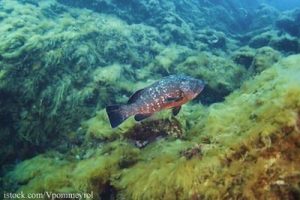An outbreak of Ciguatera fish poisoning (CFP) that took place in 2014 in Florida has been revealed by a report in the CDC’s Morbidity and Mortality Weekly Report (MMWR). This illness is caused by eating predatory reef fish that have the toxin in their systems. This toxin cannot be destroyed by cooking or freezing and there is no antidote for it.
 On November 3, 2014, the Florida Department of health in Orange County received a report from their online foodborne illness complaint system that a patient describing paresthesias (tingling or burning sensation) and numbness had seen a doctor. That person got sick on October 31, 2014, one day after eating two meals of fish. A single case of ciguatera fish poisoning in Florida is considered an outbreak.
On November 3, 2014, the Florida Department of health in Orange County received a report from their online foodborne illness complaint system that a patient describing paresthesias (tingling or burning sensation) and numbness had seen a doctor. That person got sick on October 31, 2014, one day after eating two meals of fish. A single case of ciguatera fish poisoning in Florida is considered an outbreak.
Data sources identified five additional CFP cases. Government officials collaborated to conduct investigations at two restaurants, one grocery store, two fish distributors, and one fish supplier to identify the outbreak food source. The six ill persons ate black grouper either at a local restaurant or purchased at a grocery store. The fish was traced back to a common international distributor. None of the patients, the restaurants, the grocery stores, or the distributor were identified in the report.
The initial investigation identified the first patient as an adult female who did not live in Florida who ate mahimahi at restaurant A on October 30, then a black grouper filet at restaurant B the same day. The woman experienced paradoxical temperature perception, where hot things feel cold and cold things feel hot, tingling, extremity numbness, a metallic taste, nausea, vomiting, abdominal pain, diarrhea, fever, and dizziness.
The Florida Department of Orange County Health queried surveillance systems to try to find other patients. They found an email alert from ESSENCE-FL (Early Notification of Community-Based Epidemics-Florida0 that on November 5, 2014, within a period of 22 minutes, four people went to one Orange County emergency department for “food poisoning.” A report that the patients ate “bad fish” was found in all four medical records. the patients were discharged with diagnosis of gastroenteritis.
All four of those patients, who belonged to the same family, and a fifth person from that same family shared a meal of black grouper fish heads on November 3, 2014. They were purchased from grocery store A on the same day that they were eaten. Symptoms began 3 hours after the meal and included symptoms typical of CFP, including flawed temperature perception, numbness, and tingling.
Patients in this outbreak ranged in age from 36 to 64 years, with a median age of 47. Four were male. The interval between eating the fish and getting sick ranged form three to 7.25 hours. All patients experienced paradoxical temperature perception, nausea, tingling, numbness, abdominal pain, diarrhea, joint pain, and muscle pain.
Supportive care was provided to the five patients, but none of them received intravenous mannitol (a sugar solution), which can be effective in reversing the symptoms of CFP.
Restaurant B and grocery store A both received the grouper from supplier A. Supplier A facilities were inspected and inspectors found that the implicated lot of black grouper was received whole, then divided into filets sold to restaurant B and fish heads sold to grocery store A. The black grouper was caught in Mexico. No leftover fish from the meals that caused that illness was available for lab analysis.
If you have eaten fish, particularly large predatory reef fish such as grouper, barracuda, parrot fish, amberjack, coral trout, Spanish mackerel, wrasses, king mackerel, snapper, or moray eel, and have experienced the symptoms of CFP, see a doctor as soon as possible. Symptoms can be alleviated with medical treatment, although there is no antidote, or cure, for the toxin.
This toxin is produced by marine algae that live in warm waters. Smaller fish eat the algae, and those fish are eaten in turn by larger fish. The toxin accumulates in the fish’s flesh. When someone eats a fish containing that toxin, they get sick.
To protect yourself against this type of food poisoning, always look for warnings about ciguatera if you fish to eat. Don’t eat fish that weigh more than six pounds. And avoid eating the guts of fish, where the toxin is most likely to accumulate.





Can the fish be tested for Ciguatera before being packaged?
Good question! I did some research and didn’t find any mention of scientific tests for the toxin, although there is a lot of folklore out there. The only way to avoid it is to be aware of ciguatera warnings put out by states, and to avoid eating large predatory reef fish. Barracuda and moray eel are especially likely to contain the toxin.
The CDC states that if a person does get sick, there is a test that can be conducted on the fish leftovers, if there are any. But that testing is expensive, requires special techniques and equipment, and is and time-consuming and usually isn’t done because there are no specific treatments for any type of marine fish poisoning.